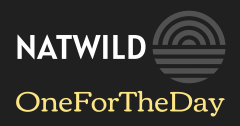June 10, 2025 5:04 pm
Sting or not, bite or not: it’s all natural for insects in the unseen world
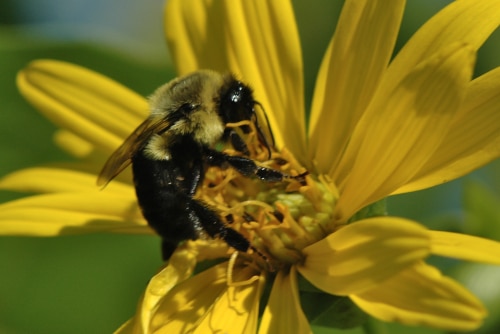
Bee -Lets Dance
Insects in the natural world
Like all life forms, the fundamental prime purpose of life is to survive long enough to reproduce.
Without this, life would not persist.
From single-celled organisms to the colossal dinosaurs, all have engaged in reproduction.
OneForTheDay by Nats.
Life of an insect
There is no mercy in the daily lives of insects.
It is eat or be eaten.
Both of those [how it happens] functions would be deemed repulsive by comparison human standards.
It’s not pretty and it’s not fine dining.
If the prey can be overpowered, it would be seen as fair game for the next step.
Mimics
Mimics With A Bite
Insect bites and stings range in pain severity on humans according to a pain scale index.
This scale index was developed by an entomologist that subjected himself to bites and stings.
Explore the Sting pain index wiki.
The Bumblebee Mimic Fly
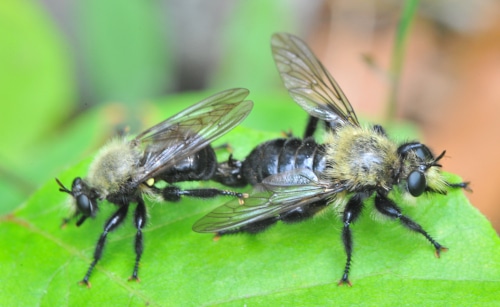
Check-Mate
I found this pair of [mating] bumble bee mimic flies on the outskirts of a forest where the tree line stops.
There is a mixture of wildflowers, grasses and fallen trees that provides a perch for the smaller world.
The local insect kingdom is on display.
Also known as a Robber Fly.
A quick glance and it would be so easy to mis-identify this fly as a bee.
However, this bee looking insect has only two wings and is a fly.
Bees have four wings.
The bumble bee mimic does not possess a stinger, but it can bite.
The bite to humans can be painful.
Best advice… do not agitate them into aggression.
The next photograph, not really a mimic, but also belongs to the Robber fly family, so I wanted to include it here as it can also deliver a painful bite.
Assassin Fly -a Robber Fly
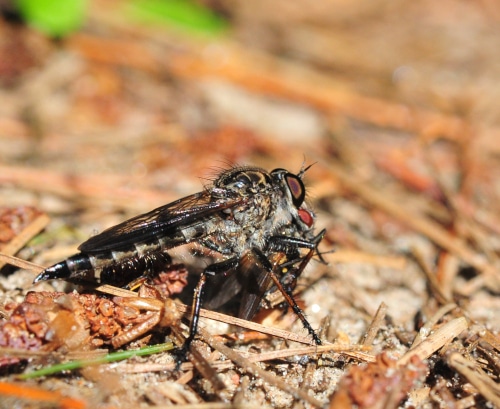
Assassinating
Robber flies get their name from the ambush style of pursuit of prey -laying in wait like a highwayman robber!
The assassin fly has a piercing probiscis, that penetrates soft tissue of prey and injects a toxin that paralyzes prey quickly and liquifies the preys’ contents to enable the removal by sucking it out.
Not my cup of tea, but each to their own!
Hoverfly
A wasp mimic with its yellow/orange and black banding.
The larvae of these insects are good at keeping aphid populations down, a gardener’s friend.
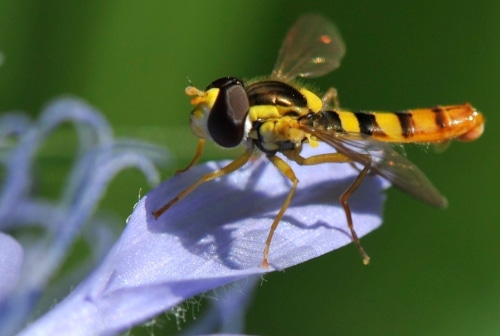
Also know as Flowerfly
Below is an adult Hoverfly feeding on pollen.
This location yielded many species of insects, as one variety after another came into camera view. Taylor Creek Reservoir along the [east side] Don Valley Parkway.
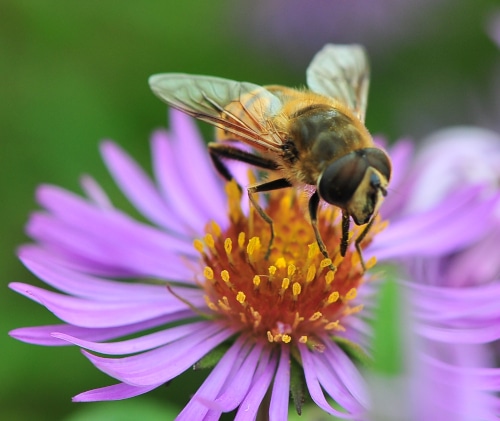
Adult Hoverfly
Bees And Wasps
Common Eastern Bumble Bee -a honey bee

Pollen hungry
The longer antennae is an indication of a bee, when it is not obvious of having four wings.
Bees can sting!
Their diet is pollen and nectar.
May I Just Take A Quick Timeout To Talk To You
About Your Extended Warranty?
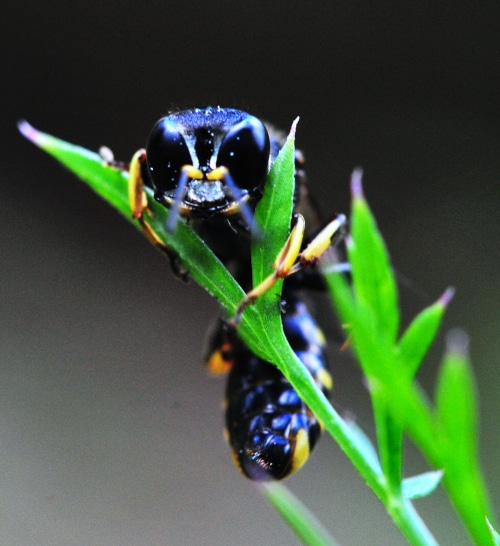
Extended Warranty?
Solitary wasps
The Red-banded Sand Wasp

Sand wasp
The red banded sand wasp builds a nest in sandy environments.
It often uses small stones/ sand granules to mark the nests entrance.
Although the above photograph shows the sand wasp on a tree stump, the stump location was indeed on sandy earth.
Inside the nest in its own individual cell chamber [of which there would be many], a single egg is laid on the captured prey.
Food provision is provided by the female, often a paralyzed caterpillar.
They are viewed as pollinators, more so because of their food searching activities for prey -caterpillars and beetles that inhabit close to pollen bearing plants.
The red banded sand wasp also belongs to the ant family of insects.
The Great Golden Digger
Here is another solitary wasp in the class of insects that sure looks like it’s built for intimidation.
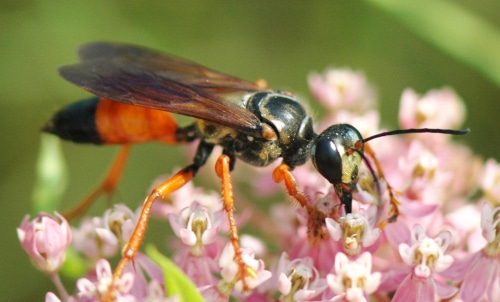
Great Golden Digger
The Great Golden Digger is a large wasp and a formidable hunter of prey that consists of grasshoppers, crickets and the like.
They are non-aggressive to humans and males do not have a stinger.
I have observed many goldies and they have never shown even a slight interest in my activities photographing, even if I go close in.
The first time photographing was filled with tension on my part, not knowing the insects characteristics.
They are well focused on their daily lives and are best left to allow them to do it.
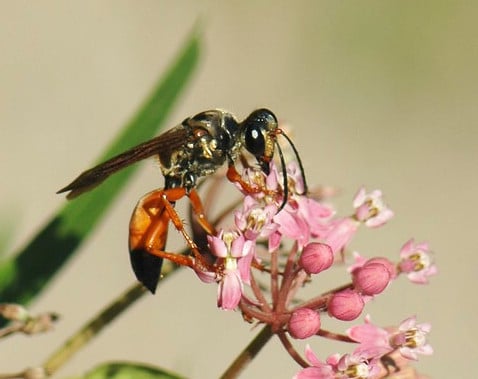
Great Golden Digger
The female is the prey hunter, nest builder, food provider and carries the sting.
The nest is excavated in soft earth/sandy terrain. Tunnels with single celled compartments will house one egg, placed on a paralyzed victim and the individual cell is sealed up.
The adult diet may just consist of nectar.
A favored plant for this is the milkweed/silkweed flower that many winged insects seek out.
The Great Golden Digger is deemed beneficial to humans because of the pest reduction and ground aeration from nest tunneling.
Ichneumon wasp
This wasp came to the rotting log that I was sitting on in search of an egg laying location.
The female has an extraordinary long ovipositor.
This is not a stinger but an egg laying appendage that is often longer than its body.
I breathed a sigh of relief.
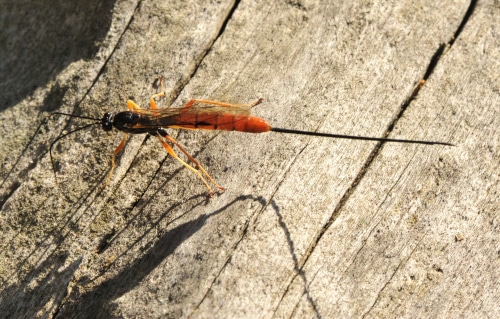
Ichneumon Wasp – Female
These insects use their antennae to hear/feel the vibrations of other insects that have found their way under the bark, like wood-boring pests.
Once the prey has been precisely located, she will pierce through the bark and into the body of the grub/larvae or adult pest with the ovipositor, to lay its eggs.
When the eggs hatch the larvae will feed on the host and find their way to the outside world.
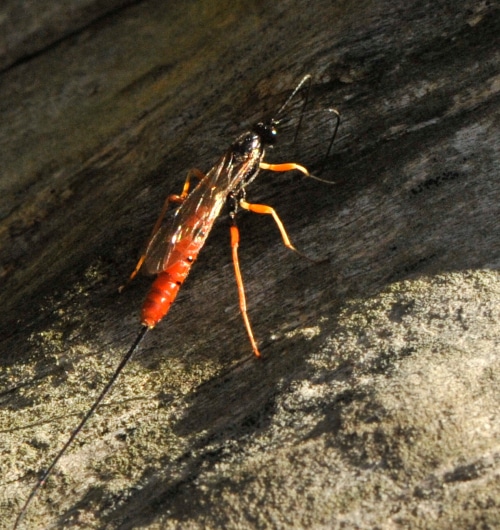
Listening
Below shows the markings of such an undertaking, with individual traces of the next generation left on the wood beneath the bark.
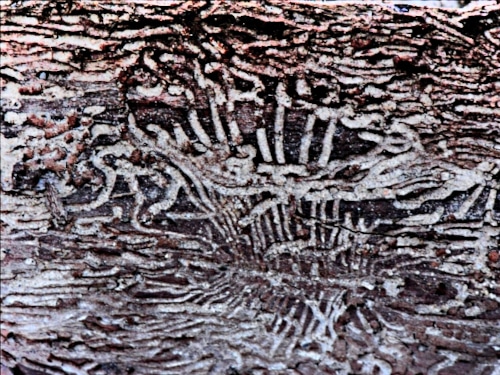
Larvae tracings outward from the host.
Ichneumon wasps are beneficial to plants, in that they can keep the wood-boring pest numbers down.
These insects are not harmful to humans, but the length of that ovipositor looks very ominous!
Spiders/Arachnids
Daddy Long legs
The Harvestman -goes by many other names colloquially.
Technically not a spider, but an arachnid.
The female tends to be larger than the male.
As with many spiders/arachnids these insects, once they reach adulthood become fiercely territorial. [perhaps even before adulthood]
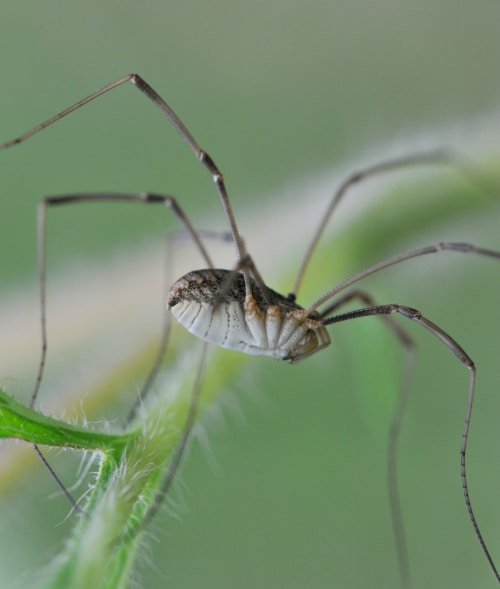
Harvestman
The diet of daddy longlegs consists of smaller insects, plant material, including fungi and carrion.
They are prey for rodents, birds, reptiles and other arachnids.
Their bite is nontoxic for humans, if they are able to penetrate the skin.
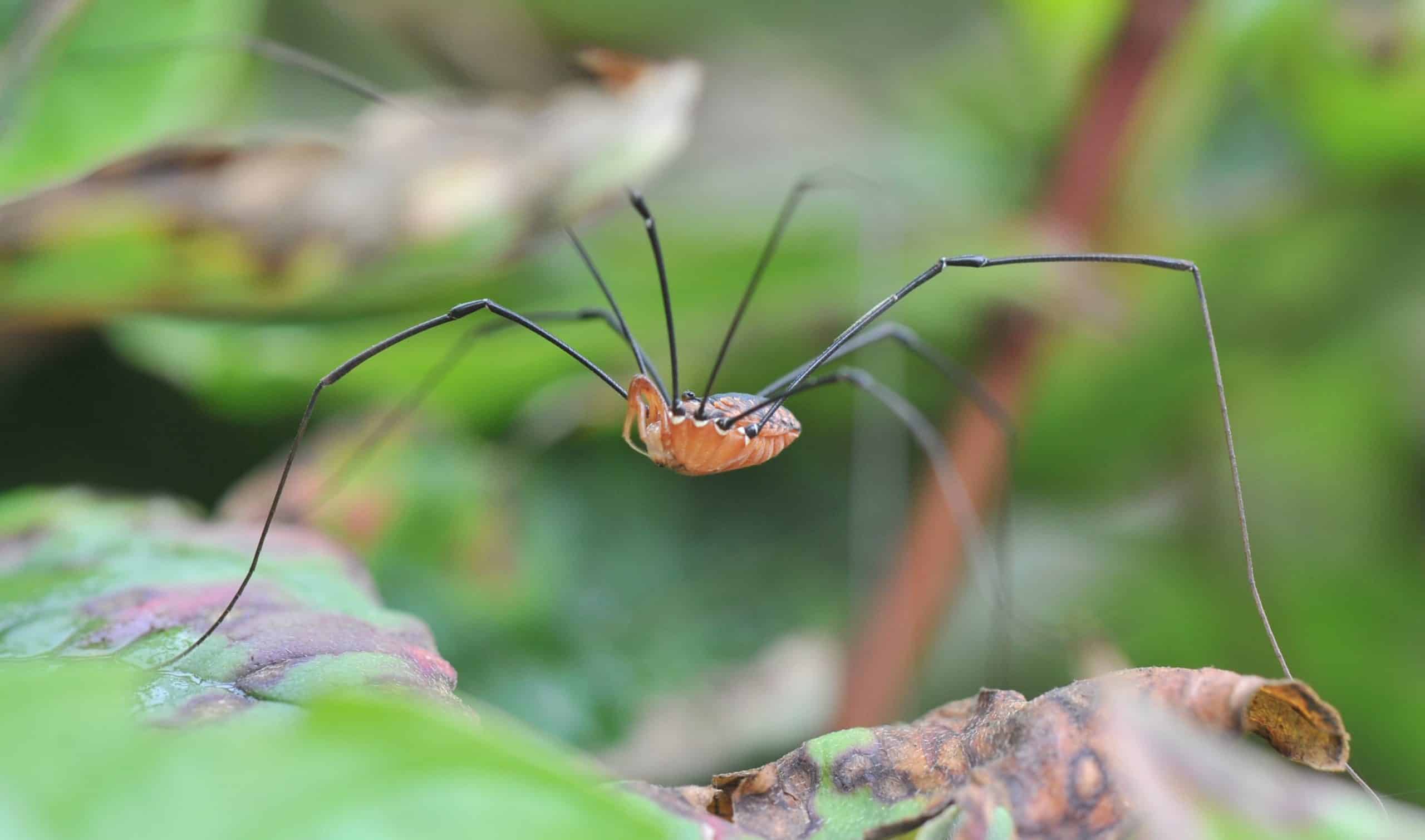
Daddy Longlegs
Banded Argiope
Like most spiders and other insects, the Banded Argiope are opportunistic predators.
If the prey is small enough to get trapped in its unique style web, then it is considered a food item.
The bite to humans is similar to a bee sting.
The venom can be harmful to animals.
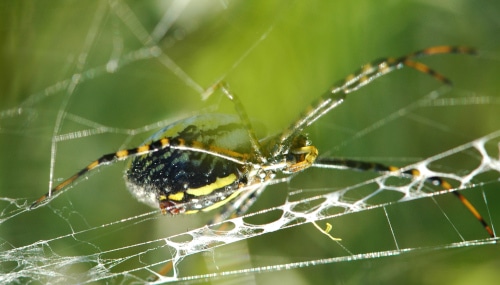
Banded Argiope
With the diet they have, they are considered a benefit to plants.
Banded Argiope are frequently found in meadows, home gardens and places where the food items are abundant.
When at rest on its web, this spider likes to lay in wait on the underside of the web, upside-down.
Should I be feeling kinship with that?
They are easy to agitate, but I try not to.
A friend told me!
They have many [also known as] names.
Shamrock Orb Weaver
Also known as Pumpkin Spider -it looks like they carry a pumpkin on their back!
They can and do bite if agitated -the bite is similar to a bee sting.
[so I’m told!]
The venom can be harmful to animals.
I found this one in a well-manicured garden, with a mixed variety of perennials.
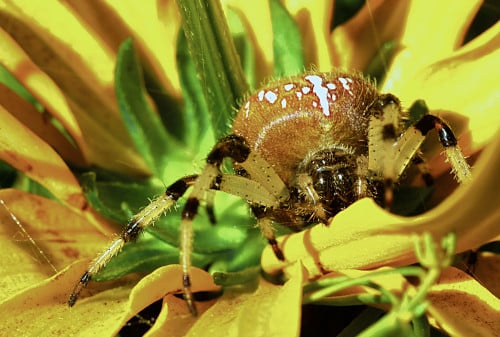
Heres looking at you
These orbweavers very seldom stay at the same web for long, with a preference to weave a new one daily.
Their web is not the typical round shape spun by other spiders.
The orbweavers web is often a long rectangular shape with roundish holes along the length.
Males are smaller as in most spider species.
The females can lay over two thousand eggs at a time!
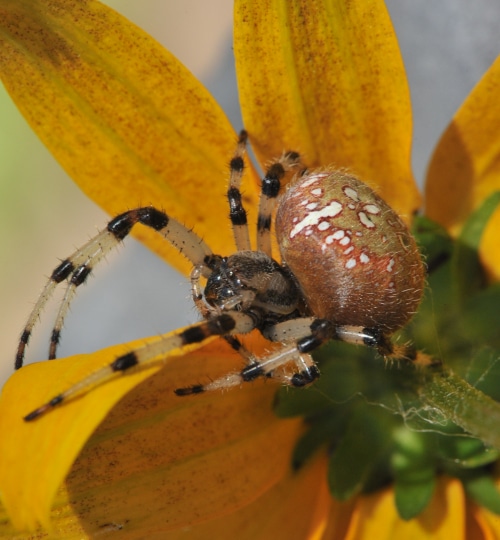
Shamrock Orbweaver
Being a predator, the diet consists of insects that get caught in the web
– flies, mosquitoes, butterflies and moths.
They would also pursue ants, beetles and aphids.
Grasshopper
There are many varieties of grasshoppers.
They are considered pests to the plant world as they consume plant material with a voracious appetite.
Having longer back legs gives grasshoppers the ability to jump to distances well over ten times their body length.
Those distances can mean life or death when confronted with predators.
Grasshoppers are prey for many earthbound, aquatic and aerial predators.
They are also menu items in some cultures around the planet.
[not for me though]
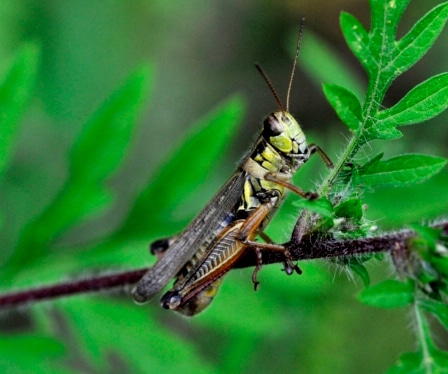
Grasshopper
They use camouflage as a cloaking device to avoid detection.
If detected they can also make use of their wings, fleeing escape or moving to greener pastures.
Grasshoppers are locusts and can swarm into clouds of extreme numbers.
Needless to say, crop farming can be destroyed with devasting results.
By rubbing their legs together, they can make sounds like crickets do with their wings.
Beetle
Japanese Beetle/Ladybird
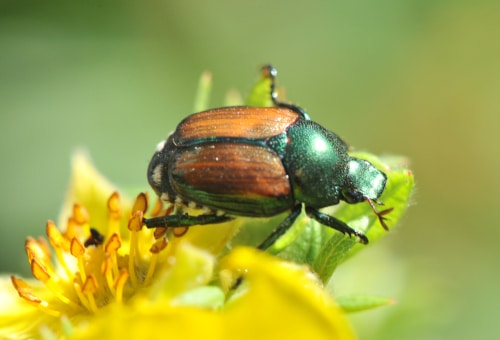
Japanese Ladybird
The Japanese ladybird has a variety of colors, feeding on small insects, insect larvae, aphids, mites, eggs and decaying carrion.
They are deemed a benefit to plant life.
The ladybirds have wings and are very capable of flying.
The wings are carefully tucked under their outer hardened shell -the elytra.
When agitated to defense mode, they do play dead and emit an unpleasant smelling/tasting liquid from their leg joints that can deter predators.
Many beetles have this defense mechanism.
Asian Ladybird
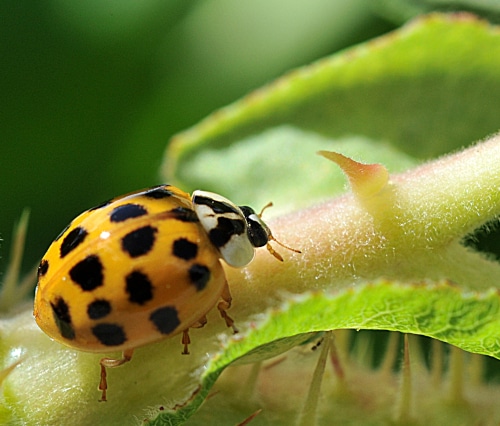
Asian Ladybird bug
The Asian Ladybird shares almost all the characteristics of the above Japanese ladybird beetle ,-its size, body shape, defense abilities, food selection and habitat.
The color markings differ.
Asian Ladybugs have multiple spot markings on their wing covers. [elytra]
They also can have an assortment of shell cover colors.
This yellow one was found on rose bushes, a perfect place for aphid and mite hunting.
I have seen others with darker shades.
These insects are deemed beneficial to plants because of their food selection.
Beetles play a significant role in the world of insects.
Some beetles are pollinators -roaming across flower heads;
some are not -chewing the leaves en-masse of pollen bearing plants.
Many beetles -the ground dwellers have diets of small insects, ants, mites, carrion and fecal matter.
The two beetles below have very similar appearances, and I wanted to display both of them.
Common Red Soldier Beetle -wings closed
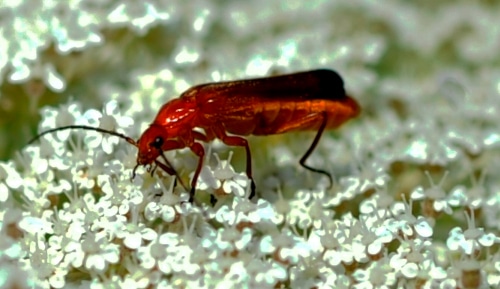
Red Soldier -Wings closed
Common Red Soldier Beetle -wings open
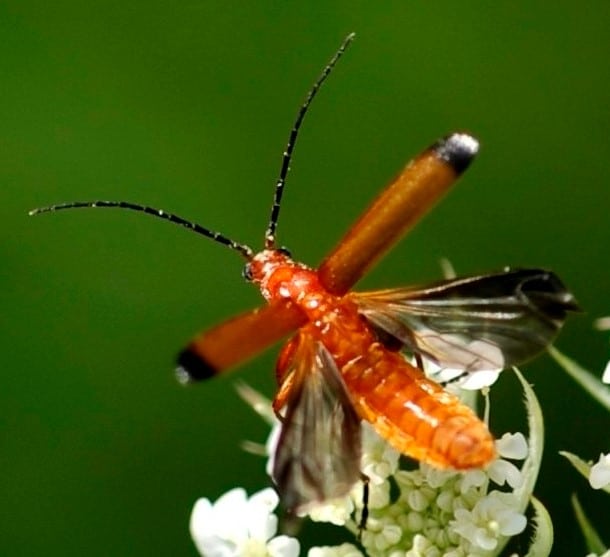
Red Soldier -wings open
These Red Soldier beetles are often seen on pollen bearing plants, roaming across the flower heads.
They are also known as Hogweed Bonking Beetle -[nice!]
A very capable flyer with two sets of wings that are tucked under the elytra when at rest.
I have frequently found them on Queen [St.] Annes Lace -a plant similar to Hogweed.
Considered very beneficial to plants for their diet and pollinating affect.
Red Milkweed Beetle -Longhorn
The Red Milkweed beetle is very similar in appearance to the Red Soldier beetle.
They can be distinguished quite easily though -the shape of its antennae – its a longhorn beetle. It also has black spot markings on the elytra.
Their eyes have the remarkable ability to see both upward and downward at the same time.
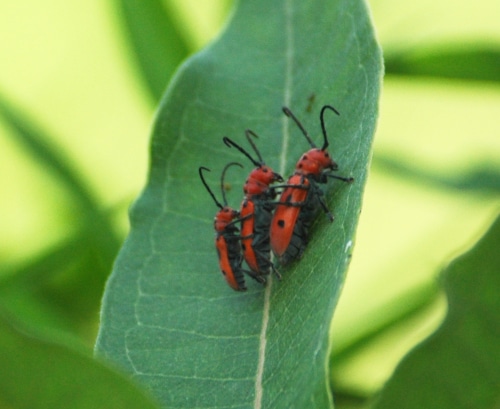
Red Milkweed Beetle
This beetle is considered harmful to plants because of its diet of roots, stems, leaves, flower and seeds of the milkwood plant.
These insects may be considered a pollinator because its diet also includes pollen. {Sometimes, it’s wise to be cautious about what you wish for.]
Caterpillar
Caterpillars are larvae of butterflies and moths.
Some are hairy, bristly and have a variety of colors that never seem to match the adult winged insect.
Being slow moving and having few defense mechanisms, caterpillars fall prey to a great number of creatures looking for food.
Wooly Bear Caterpillar
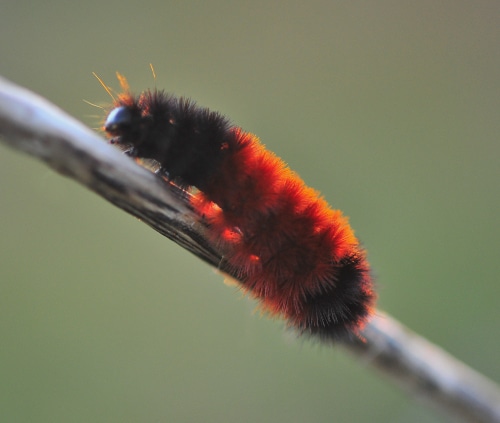
Wooly Bear
The Wooly Bear caterpillar is the larva stage of the Isabella Tiger Moth.
From its appearance, who’d have thunk that!
Also Known as Black-ended Bear.
These insects are often seen at the late stages of summer and through fall.
[In Ontario]
They do have a bear-like head shape with sturdy hardened legs, that resemble claws.
Eastern Tent Caterpillars
These tent caterpillar insects are species of Lappet moth.
They are deemed harmful to humans and cause destruction to plants.
Often found on deciduous trees, shrubs and succulent hedgerows in summer. The telltale signs are quite evident once the colony takes hold.
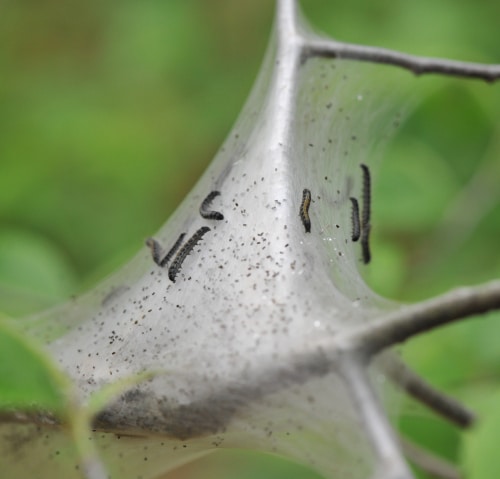
Tent Caterpillars
The structure that Eastern tent caterpillars build is compartmentalized into chambers.
The chambers help to defend against predators and aid with temperature control.
Although the foliage gets depleted within the tent compound, it does so in the early stages of their life as larvae, where survival within a safe haven is critical.
As the larvae grow, their appetite increases and forages outside the tent are necessary to survive.
The tent is used as a climate-controlled aid for digestion of plant material.
Once the larvae have reached their last phase, the tent is abandoned in search of places to cocoon -which may take about two weeks to pupate.
When the moths emerge, they will no longer eat -they have no mouth chewing parts only a probiscis for sucking nectar.
The adult moth insects have only one purpose -to reproduce.
The new feathery antennae they now possess, acts as a pheromone seeker in finding mates.
Once the eggs are laid, the female may only last a single day.
And so the cycle continues.
Tussock Caterpillar
The Tussock caterpillar, a larva covered in bristles, can make it challenging to discern which end of the insect’s body is the head when it is at rest..
In the photograph, the head is positioned on the right side, indicated by the presence of more facial hair..
If the Tussock caterpillar survives to adulthood, a moth will emerge from the cocoon.
Male and female moths exhibit a broad diversity in appearance. Some female moths are wingless and may be significantly smaller than their male counterparts..
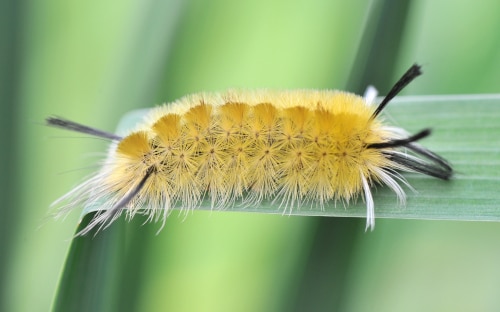
My Head Is On The Right
At the caterpillar stage, the bristly hairs may hide more rigid defensive hairs that can cause pain [or agitation] if they pierce the skin of humans, insects, or other predators.
The spongy moth is one variety of tussock caterpillar.
Steer clear or handle with care!
Introduced Eastern Pine Sawfly
At this stage, Pine Sawfly larvae consume pine needles, potentially causing damage to trees due to their voracious appetite.
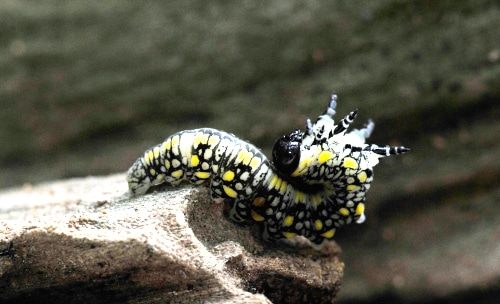
Defensive Posture
Initially, I believed it to be a monarch butterfly larva due to the similar coloration and patterns. Yet, the geographic location of the species did not align.
As I moved closer to take a photograph, it adopted a defensive posture, much to my delight!
They are considered nontoxic, but are harmful to plants.
During the larval stage, they often feed collectively, initiating group behavior through body vibrations to communicate.
Pollinators
Insects are absolutely vital in the pollination of plants.
The weather and roaming creatures can only do so much.
Bees contribute to the pollination process greatly in their industrial behavior of collecting pollen for the collective benefit of the hive.
They also drink the nectar for the nutrition it offers.
Bees also give back honey in the quasi-symbiotic process -priceless!
[I state quasi-symbiotic because of the chemicals sprayed on crops, and insect repellents used that interfere with the natural biology and the relationship between insects and plants.]
We need to acknowledge more of the tireless effort that insects play in the pollination process.
Without them, just imagine!
Common Bumblebee
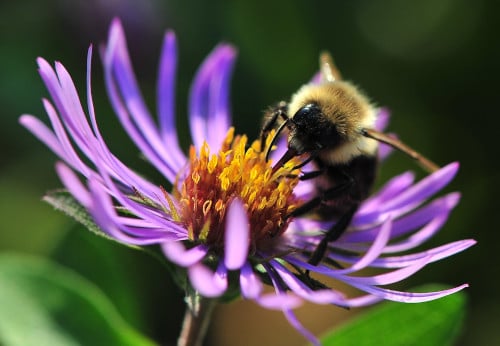
Common Bumblebee – a Honeybee
Butterflies
Pearl Crescent Butterfly
This butterfly was a new find for me.
Found in Oak Ridges Moraine near Aurora, Ontario – at the edge of a forest trail.
At first, I labelled it a fritillary. Their appearance is so similar.
Ants protect the larvae in exchange for sweet nectar produced by the juveniles from eating a variety of plant flowers.
This species is considered harmful to plants, however they are also pollinators as winged adults.
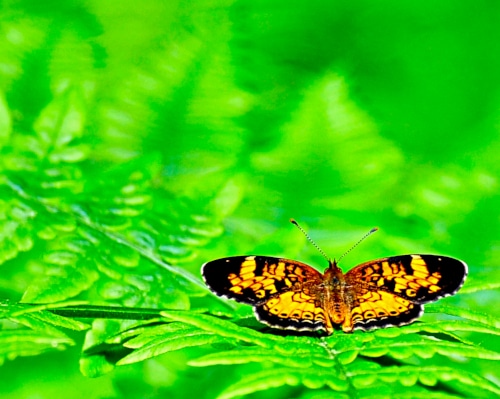
Pearl Crescenty – Butterfly
As with the larva stage of all insects, their prime goal is to eat, eat and eat.
Once the adult emerges to the winged stage its only focus is to breed.
The Pearl Crescent butterfly females tend to group together, while the males seek pooled water to defend territorially.
They do not have mouth chewing parts as adults but use their probiscis to feed on nectar for nourishment.
The next two insects in the butterfly world are two that I like to find.
Eastern Black Swallowtail Butterfly
The Eastern Black Swallowtail is one of the larger butterflies.
The photograph below is of a female, found at Humber Bay Park, Toronto.
They are considered very strong flyers.
I watched this one dance in the strong winds near the shore.
[probably seeking a mate by dispersing pheromones into the air]
The Eastern Black Swallowtail can often breed more than once in a warm long season.
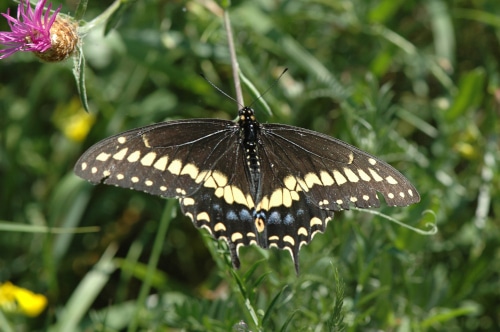
Swallow-tail Butterfly
They prefer plants like Queens Annes lace, carrot, parsley, milkweed and others on which to lay eggs.
The selection of plant-based food also provides the larvae with a defense against predators, as the toxins within the plants result in an unpalatable taste.
Monarch Butterfly
Monarch butterflies are highly dependent on the milkweed plant.
Eggs are laid on the undersides of leaves.
The larvae feed on the leaves and pollen.
The adult butterfly sustains itself on the nectar of flowers.
Milkweed is a hardy perennial plant that provides food sources to countless insects everywhere that it is allowed to grow.
Crop farmers view milkweed as a plant that they can do without and do not want it near the crop fields.
Milkweed is also known as silkweed. The large seedpods contain many seeds that have filaments of lightweight silk-like fluffy, floss attached to each seed.
The seeds are easily dispersed by the wind like dandelion seeds.
The silk-like floss has been used commercially for pillow filler and even floatation devices.
The seeds are used as food sources for wildlife.
Monarch butterflies are considered beneficial to plants.
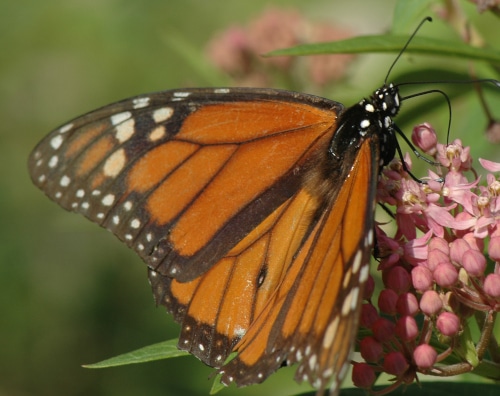
Monarch On Milkweed
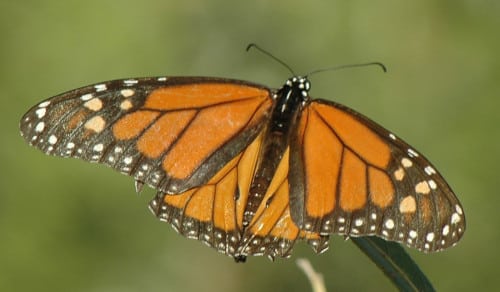
Monarch -Wings Open
Monarch butterflies in Canada and North America, undergo an incredible migration journey.
The migration is an annual event that can take generations to complete!
The migration point favored by millions {perhaps billions] of butterflies is to a hilly treed location in Mexico, where they settle to over winter.
The precise location is kept secure, to prevent disruption of this process.
I have to ask an open question…… how do they do it?
The migration quest can take two, three or four generations of butterfly to complete the round trip!
Essex Skipper Butterfly
These insects are considered invasive species in North America because they were introduced from Europe around the turn of the twentieth century.
The adults are often found syphoning nectar from colorful tubular flowers, as in this case – from vetch. [a common weed wildflower]
The European Skipper is a smaller variety of butterfly that I tend to see more towards dusk.
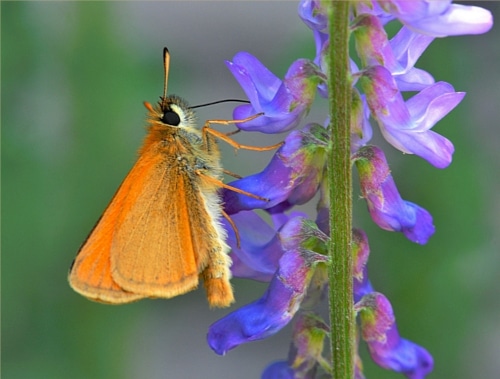
Essex Skipper
This Skipper prefers grasses on which to lay eggs.
The young caterpillars use the spring grasses as food.
The winter is spent cocooned in grass leaves folded over and bound by silken woven threads.
Moth
Hummingbird Hawk Moth
These insects seemed to have learned something from its namesake
-hummingbird.
They do indeed make a humming sound when flying and hovering to feed on nectar.
Their wings beat fast like hummingbirds, and the probiscis is long enabling them to reach the nectar of tubular shaped flowers.
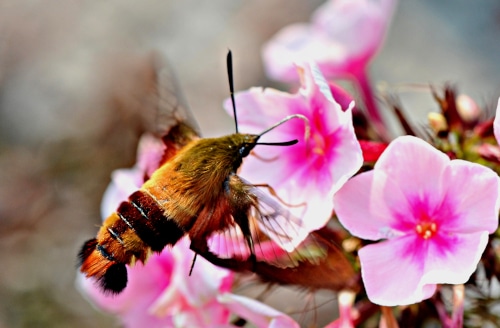
Hummingbird Hawk Moth
This moth came to visit daily for several days to this same flower bed.
These flying insects are not a rarity in Canada, but I have only seen a few -however I have not conducted specific searches around their preferred habitat.
It was a delight to experience this occurrence for a few days.
Hummingbird Moth insects are considered good pollinators and are attracted to fragrant flowers daytime and nighttime.
Mantis
European Praying Mantis
This wonderful insect was found in a manicured garden that I was landscaping.
The mantis is a long-legged, winged insect that hunts pests like aphids, grasshoppers, crickets and others that it can overpower.
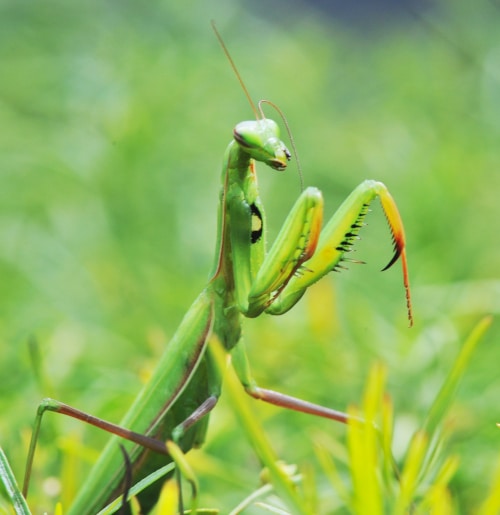
Mantis
Their head has remarkable maneuverability and allows 180 degrees of rotation.
The front legs have a large claw and stiff bristles to enable the holding of captured prey.
Inside the upper front legs, the European mantis has a spotted feature, that is used to display when in a defensive position -acting as eyes.
The mantis is well camouflaged when in grasses.
This insect seemed unperturbed when it was handled for removal to a safer location. They generally do not pose a threat to humans and are beneficial to gardens.
Those claws do look daunting though!
Millipede
The Millipede is actually NOT an insect, being more closely related to shrimp!
An arthropod.
But it crawled into this post when my back was turned!
The millipede favors damp or moist conditions and feeds mostly on decaying vegetation matter. Although it is viewed as a pest when it feeds on emerging succulent new growth.
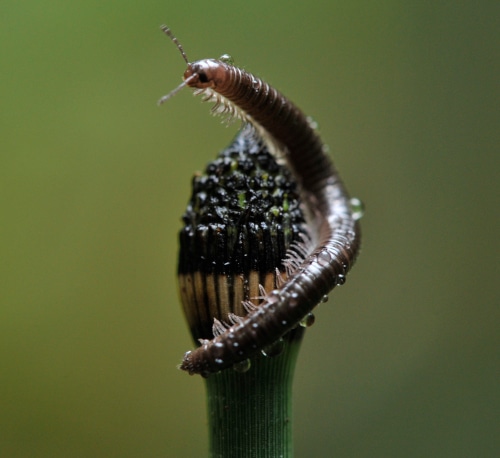
Millipede
I hope that you have enjoyed this post and found some fun facts about some of the insects that I have investigated and photographed.
This is not intended to be used as reference material, just snippets that I have collected for my purpose, along my trek through nature.
More to come!
Stay safe!
OneForTheDay by Nats.
Nats, a photographer, writer, and contributing editor for natwild.com and the OneForTheDay blog, is reachable through this site. Feel free to log in, subscribe, and leave comments.
Please leave a comment below.
Register / Login required to comment
